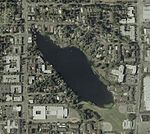Ingraham High School

Ingraham High School is a public high school, serving grades 9–12 in the Haller Lake neighborhood of Seattle, Washington, United States. Opened in 1959, the school is named after Edward Sturgis Ingraham, the first superintendent of the Seattle Public Schools. Since 2002, Ingraham has been an International Baccalaureate school, and also offers programs such as the Academy of Information Technology. Since the 2011 school year, Ingraham has also offered an accelerated model of the International Baccalaureate program (IBx), modeled on a similar program in Bellevue School District, allowing students in Seattle Public Schools' highly capable cohort (formerly Accelerated Progress Program).
Excerpt from the Wikipedia article Ingraham High School (License: CC BY-SA 3.0, Authors, Images).Ingraham High School
North 133rd Street, Seattle Haller Lake
Geographical coordinates (GPS) Address External links Nearby Places Show on map
Geographical coordinates (GPS)
| Latitude | Longitude |
|---|---|
| N 47.725833333333 ° | E -122.33777777778 ° |
Address
Ingraham High School
North 133rd Street
98133 Seattle, Haller Lake
Washington, United States
Open on Google Maps





